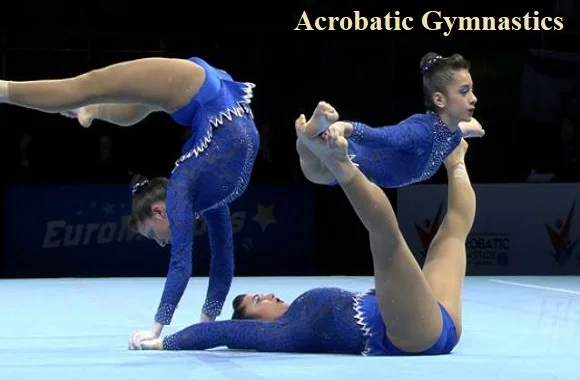Acrobatic gymnastics is a sport where athletes use rigorous routines to portray various difficult poses, balances, and stunts. The purpose of these movements is to demonstrate an athlete’s strength, flexibility, and grace along with their mental focus.
Gymnasts are able to perform many different disciplines in gymnastics including tumbling, static balance, aerial skills, and partner skills. It is the sports that are governed by the International Federation of Gymnastics.
History of Acrobatic Gymnastics sport
The history of acrobatic gymnastics begins in the 1800s. Acrobatics is an ancient form of gymnastics that includes stunts and tricks, most commonly using ropes.
Acrobats are often performed to entertain people at festivals, carnivals, circuses, and sporting events. It’s a sport that starts with A. The sport was first contested in the Soviet Union, in the 1930s.
A short history of the sports
You can check here short some information about Gymnastics.
Highest Governing Body: Fédération Internationale de Gymnastique
Starting first contest: the Soviet Union, the 1930s
Mixed-gender: No (except mixed pairs)
Country or Region: Worldwide
Olympic: No.
World Games: 1993-2021
Acrobatic Gymnastics Equipment
Equipment used in Gymnastics includes but is not limited to:
1) Ball
2) Catch-bar
3) Clubs
4) Double-legs
5) Floor
6) Floor mats
7) Gymnast’s shoes
Here is a short list of equipment commonly used in acrobatic gymnastics:
- Gymnastics Mats: Thick, padded mats are used for practicing and performing acrobatic moves. These mats provide cushioning and safety during tumbling, flips, and landings.
- Balance Beams: Balance beams, similar to those used in artistic gymnastics, are sometimes used in acrobatic gymnastics routines.
- Acrobatics Mats: Specialized mats designed specifically for acrobatic gymnastics are used for tumbling and partnering skills.
- Handstand Canes: Handstand canes, or hand balancing canes, are used for handstand variations and hand balancing skills.
- Aerial Apparatus: Aerial apparatus, such as aerial hoops or aerial silks, may be used in acrobatic gymnastics routines to incorporate aerial and circus-inspired elements.
Rules of Acrobatic Gymnastics
(the “award”), a certificate of participation in the competition, a certificate of participation in the competition, a certificate of participation in the competition, a certificate of participation in the competition, a certificate of participation in sports, a certificate of Sports.
There are four FIG categories at the international level of rivalry defined by age; 11–16, 12–18, 13–19, and 15+ (Senior).
Partnerships in Gymnastics have been given to the different genders
- Women’s pair: two females
- Men’s pair: two males
- Mixed pair: a male base and a female top
- Women’s group: three females
- Men’s group: four males
People also ask to know
What’s the difference between gymnastics and acrobatics?
Gymnastics is a physical activity that requires strength, flexibility, and balance. It includes exercises such as vaulting, tumbling, trampoline jumping, floor gymnastics (tumble Sanskrit), hoop dancing (hoop magic), and cartwheels.
Acrobatics is an athletic discipline that combines elements of gymnastics with performances on unbalanced or aerial objects such as hoops, trapeze cords, bars, or other structures.
Gymnastics and acrobatics are two different types of athletic training that focus on movements with gravity. Gymnastics is more about strength, balance, and flexibility while acrobatics is all about movement above the head or in the air. Acrobats often perform stunts such as flips, tumbles, and cartwheels that require incredible coordination and control.
Both sports have their benefits; gymnastics can help you improve your overall fitness level by building muscle tissues and working on core stability exercises while acrobatics can be a fun way to exercise your imagination and creativity.
What are acrobatic elements in gymnastics?
Like with other gymnastics disciplines, Acrobatic Gymnastics derives its fundamental aspects that define the sport’s physical expression from the same source. The difference between one gymnastics discipline and another is choreography, agility, balance, strength, grace, and the use of equipment.
Will acrobatic gymnastics ever be in the Olympics?
There is a chance that acrobatic gymnastics might one day be considered for inclusion in the Olympics. This sport has been growing in popularity over the past few years, and it features highly difficult and risky moves that require great dexterity and Balance. To be eligible for Olympic competitions, acrobatics would need to pass certain safety guidelines and undergo extensive regulation by world governing bodies.
There is a good chance that acrobatic gymnastics will one day be an Olympic sport, as the inclusion of this discipline has been contentious for many years. Acrobatic Gymnastics was first added to the modern Olympics in 2000, but it was removed eight years later due to controversy over its similarity to tumbling.
In addition to being entertaining spectacles on TV screens across the world, aspiring Olympians take part in training camps called “gymnasia” year-round in order not to miss a beat during their journey to becoming global stars. So whether you’re cheering for your favorite team or just looking for something different to watch on television – keep your eyes peeled for future events featuring acrobatics and gymnastics!
In conclusion
The Sport won the award, Acrobatic Gymnastics won the award, the Acrobatic Gymnastics won the award, award at 1:30. I think, already I have submitted all data about the Gymnastics sports.
Read also related sports
Acroski and more










